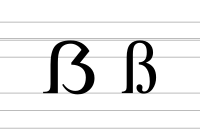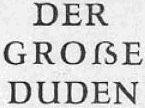Ss
In German orthography, the letter ß, called Eszett (IPA: ) or scharfes S (IPA: , sharp S), represents the /s/ phoneme in Standard German when following long vowels and diphthongs.
The letter-name Eszett combines the names of the letters of ⟨s⟩ (Es) and ⟨z⟩ (Zett) in German. The character's Unicode names in English are sharp s and eszett. The Eszett letter is used only in German, and can be typographically replaced with the double-s digraph ⟨ss⟩, if the ß-character is unavailable. In the 20th century, the ß-character was replaced with ss in the spelling of Swiss Standard German (Switzerland and Liechtenstein), while remaining Standard German spelling in other varieties of the German language.
| ẞ | |
|---|---|
| ẞ ß | |
 | |
| Usage | |
| Writing system | Latin script |
| Type | Alphabetic |
| Language of origin | Early New High German |
| Phonetic usage | [s] |
| Unicode codepoint | U+1E9E, U+00DF |
| History | |
| Development | |
| Time period | ~1300s to present |
| Descendants | None |
| Sisters | None |
| Transliteration equivalents | ss, sz |
| Other | |
| Other letters commonly used with | ss, sz |
| Writing direction | Left-to-Right |
The letter originates as the ⟨sz⟩ digraph as used in late medieval and early modern German orthography, represented as a ligature of ⟨ſ⟩ (long s) and ⟨ʒ⟩ (tailed z) in blackletter typefaces, yielding ⟨ſʒ⟩. This developed from an earlier usage of ⟨z⟩ in Old and Middle High German to represent a separate sibilant sound from ⟨s⟩; when the difference between the two sounds was lost in the 13th century, the two symbols came to be combined as ⟨sz⟩ in some situations.
Traditionally, ⟨ß⟩ did not have a capital form, although some type designers introduced de facto capitalized variants. In 2017, the Council for German Orthography officially adopted a capital, ⟨ẞ⟩, as an acceptable variant in German orthography, ending a long orthographic debate.
Lowercase ⟨ß⟩ was encoded by ECMA-94 (1985) at position 223 (hexadecimal DF), inherited by Latin-1 and Unicode (U+00DF ß LATIN SMALL LETTER SHARP S). The HTML entity ß was introduced with HTML 2.0 (1995). The capital ⟨ẞ⟩ was encoded by Unicode in 2008 at (U+1E9E ẞ LATIN CAPITAL LETTER SHARP S).
Usage
Current usage
In standard German, three letters or combinations of letters commonly represent [s] (the voiceless alveolar fricative) depending on its position in a word: ⟨s⟩, ⟨ss⟩, and ⟨ß⟩. According to current German orthography, ⟨ß⟩ represents the sound [s]:
- when it is written after a diphthong or long vowel and is not followed by another consonant in the word stem: Straße, Maß, groß, heißen [Exceptions: aus and words with final devoicing (e.g., Haus)]; and
- when a word stem ending with ⟨ß⟩ takes an inflectional ending beginning with a consonant: heißt, größte.
In verbs with roots where the vowel changes length, this means that some forms may be written with ⟨ß⟩, others with ⟨ss⟩: wissen, er weiß, er wusste.
The use of ⟨ß⟩ distinguishes minimal pairs such as reißen (IPA: [ˈʁaɪsn̩], to rip) and reisen (IPA: [ˈʁaɪzn̩], to travel) on the one hand ([s] vs. [z]), and Buße (IPA: [ˈbuːsə], penance) and Busse (IPA: [ˈbʊsə], buses) on the other (long vowel before ⟨ß⟩, short vowel before ⟨ss⟩).: 123
Some proper names may use ⟨ß⟩ after a short vowel, following the old orthography; this is also true of some words derived from proper names (e.g., Litfaßsäule; advertising column, named after Ernst Litfaß).: 180
If no ⟨ß⟩ is available in a font, then the official orthography calls for ⟨ß⟩ to be replaced with ⟨ss⟩. Additionally, as of 2017, when capitalized, either capital ⟨ẞ⟩ (STRAẞE) or ⟨SS⟩ (STRASSE) are considered equally valid in all situations (not just when the character is unavailable). The previous rule, codified in the Orthography Reform of 1996, had been always to replace ⟨ß⟩ with ⟨SS⟩ in allcaps.
In pre-1996 orthography

According to the orthography in use in German prior to the German orthography reform of 1996, ⟨ß⟩ was written to represent [s]:
- word internally following a long vowel or diphthong: Straße, reißen; and
- at the end of a syllable or before a consonant, so long as [s] is the end of the word stem: muß, faßt, wäßrig.: 176
In the old orthography, word stems spelled ⟨ss⟩ internally could thus be written ⟨ß⟩ in certain instances, without this reflecting a change in vowel length: küßt (from küssen), faßt (from fassen), verläßlich and Verlaß (from verlassen), kraß (comparative: krasser).: 121–23 In rare occasions, the difference between ⟨ß⟩ and ⟨ss⟩ could help differentiate words: Paßende (expiration of a pass) and passende (appropriate).: 178

As in the new orthography, it was possible to write ⟨ss⟩ for ⟨ß⟩ if the character was not available. When using all capital letters, the pre-1996 rules called for rendering ⟨ß⟩ as ⟨SS⟩ except when there was ambiguity, in which case it should be rendered as ⟨SZ⟩. The common example for such a case is IN MASZEN (in Maßen "in moderate amounts") vs. IN MASSEN (in Massen "in massive amounts"); in this example the spelling difference between ⟨ß⟩ vs. ⟨ss⟩ produces completely different meanings.[citation needed]
Switzerland and Liechtenstein
In Swiss Standard German, ⟨ss⟩ usually replaces every ⟨ß⟩. This is officially sanctioned by the reformed German orthography rules, which state in §25 E2: "In der Schweiz kann man immer „ss“ schreiben" ("In Switzerland, one may always write 'ss'"). Liechtenstein follows the same practice. There are very few instances where the difference between spelling ⟨ß⟩ and ⟨ss⟩ affects the meaning of a word, and these can usually be told apart by context.: 230
Other uses


Occasionally, ⟨ß⟩ has been used in unusual ways:
- As a surrogate for Greek lowercase ⟨β⟩ (beta), which looks fairly similar. This was used in older operating systems, the character encoding of which (notably Latin-1 and Windows-1252) did not support easy use of Greek letters. Additionally, the original IBM DOS code page, CP437 (aka OEM-US) conflates the two characters, with a glyph that minimizes their differences placed between the Greek letters ⟨α⟩ (alpha) and ⟨γ⟩ (gamma) but named "Sharp s Small".
- In Prussian Lithuanian, as in the first book published in Lithuanian, Martynas Mažvydas' Simple Words of Catechism, as well as in Sorbian (see example on the left).
- For sadhe in Akkadian glosses, in place of the standard ⟨ṣ⟩, when that character is unavailable due to limitations of HTML.
- The letter appeared in the alphabet made by Jan Kochanowski for the Polish language, that was used from the 16th until the 18th century. It represented the voiceless postalveolar fricative ([ʃ]) sound. It was for example used in the Jakub Wujek Bible.
History
Origin and development

As a result of the High German consonant shift, Old High German developed a sound generally spelled ⟨zz⟩ or ⟨z⟩ that was probably pronounced [s] and was contrasted with a sound, probably pronounced [s̠] (voiceless alveolar retracted sibilant) or [z̠] (voiced alveolar retracted sibilant), depending on the place in the word, and spelled ⟨s⟩. Given that ⟨z⟩ could also represent the affricate [ts], some attempts were made to differentiate the sounds by spelling [s] as ⟨zss⟩ or ⟨zs⟩: wazssar (German: Wasser), fuozssi (German: Füße), heizsit (German: heißt). In Middle High German, ⟨zz⟩ simplified to ⟨z⟩ at the end of a word or after a long vowel, but was retained word internally after a short vowel: wazzer (German: Wasser) vs. lâzen (German: lassen) and fuoz (German: Fuß).

In the thirteenth century, the phonetic difference between ⟨z⟩ and ⟨s⟩ was lost at the beginning and end of words in all dialects except for Gottscheerish. Word-internally, Old and Middle High German ⟨s⟩ came to be pronounced [z] (the voiced alveolar sibilant), while Old and Middle High German ⟨z⟩ continued to be pronounced [s]. This produces the contrast between modern standard German reisen and reißen. The former is pronounced IPA: [ˈʁaɪzn̩] and comes from Middle High German: reisen, while the latter is pronounced IPA: [ˈʁaɪsn̩] and comes from Middle High German: reizen.
In the late medieval and early modern periods, [s] was frequently spelled ⟨sz⟩ or ⟨ss⟩. The earliest appearance of ligature resembling the modern ⟨ß⟩ is in a fragment of a manuscript of the poem Wolfdietrich from around 1300.: 214 In the Gothic book hands and bastarda scripts of the late medieval period, ⟨sz⟩ is written with long s and the Blackletter "tailed z", as ⟨ſʒ⟩. A recognizable ligature representing the ⟨sz⟩ digraph develops in handwriting in the early 14th century.: 67–76

By the late 1400s, the choice of spelling between ⟨sz⟩ and ⟨ss⟩ was usually based on the sound's position in the word rather than etymology: ⟨sz⟩ (⟨ſz⟩) tended to be used in word final position: uſz (Middle High German: ûz, German: aus), -nüſz (Middle High German: -nüss(e), German: -nis); ⟨ss⟩ (⟨ſſ⟩) tended to be used when the sound occurred between vowels: groſſes (Middle High German: grôzes, German: großes).: 171 While Martin Luther's early 16th-century printings also contain spellings such as heyße (German: heiße), early modern printers mostly changed these to ⟨ſſ⟩: heiſſe. Around the same time, printers began to systematically distinguish between das (the, that [pronoun]) and daß (that [conjunction]).: 215
In modern German, the Old and Middle High German ⟨z⟩ is now represented by either ⟨ss⟩, ⟨ß⟩, or, if there are no related forms in which [s] occurs intervocalically, with ⟨s⟩: messen (Middle High German: mezzen), Straße (Middle High German: strâze), and was (Middle High German: waz).
Standardization of use
The pre-1996 German use of ⟨ß⟩ was codified by the eighteenth-century grammarians Johann Christoph Gottsched (1748) and Johann Christoph Adelung (1793) and made official for all German-speaking countries by the German Orthographic Conference of 1901. In this orthography, the use of ⟨ß⟩ was modeled after the use of long and "round"-s in Fraktur. ⟨ß⟩ appeared both word internally after long vowels and also in those positions where Fraktur required the second s to be a "round" or "final" s, namely the ends of syllables or the ends of words.: 217–18 In his Deutsches Wörterbuch (1854) Jacob Grimm called for ⟨ß⟩ or ⟨sz⟩ to be written for all instances of Middle and Old High German etymological ⟨z⟩ (e.g., eß instead of es from Middle High German: ez); however, his etymological proposal could not overcome established usage.: 269
In Austria-Hungary prior to the German Orthographic Conference of 1902, an alternative rule formulated by Johann Christian August Heyse in 1829 had been officially taught in the schools since 1879, although this spelling was not widely used. Heyse's rule matches current usage after the German orthography reform of 1996 in that ⟨ß⟩ was only used after long vowels.: 219
Use in Roman type



Although there are early examples in Roman type (called Antiqua in a German context) of a ⟨ſs⟩-ligature that looks like the letter ⟨ß⟩, it was not commonly used for ⟨sz⟩. These forms generally fell out of use in the eighteenth century and were used in italic text only;: 73 German works printed in Roman type in the late 18th and early 19th centuries such as Johann Gottlieb Fichte's Wissenschaftslehre did not provide any equivalent to the ⟨ß⟩. Jacob Grimm began using ⟨ß⟩ in his Deutsche Grammatik (1819); however, it varied with ⟨ſſ⟩ word internally.: 74 Grimm eventually rejected the use of the character; in their Deutsches Wörterbuch (1838), the Brothers Grimm favored writing it as ⟨sz⟩.: 2 The First Orthographic Conference in Berlin (1876) recommended that ß be represented as ⟨ſs⟩ – however, both suggestions were ultimately rejected.: 269 : 222 In 1879, a proposal for various letter forms was published in the Journal für Buchdruckerkunst. A committee of the Typographic Society of Leipzig chose the "Sulzbacher form". In 1903, it was proclaimed as the new standard for the Eszett in Roman type.: 3–5
Until the abolition of Fraktur in 1941, it was common for family names to be written with ⟨ß⟩ in Fraktur and ⟨ss⟩ in Roman type. The formal abolition resulted in inconsistencies in how names are written in modern German (such as between Heuss and Heuß).: 176
Abolition and attempted abolitions
The Swiss and Liechtensteiners ceased to use ⟨ß⟩ in the twentieth century. This has been explained variously by the early adoption of Roman type in Switzerland, the use of typewriters in Switzerland that did not include ⟨ß⟩ in favor of French and Italian characters, and peculiarities of Swiss German that cause words spelled with ⟨ß⟩ or ⟨ss⟩ to be pronounced with gemination.: 221–22 The Education Council of Zürich had decided to stop teaching the letter in 1935, whereas the Neue Zürcher Zeitung continued to write ⟨ß⟩ until 1971. Swiss newspapers continued to print in Fraktur until the end of the 1940s, and the abandonment of ß by most newspapers corresponded to them switching to Roman typesetting.
When the Nazi German government abolished the use of blackletter typesetting in 1941, it was originally planned to also abolish the use of ⟨ß⟩. However, Hitler intervened to retain ⟨ß⟩, while deciding against the creation of a capital form. In 1954, a group of reformers in West Germany similarly proposed, among other changes to German spelling, the abolition of ⟨ß⟩; their proposals were publicly opposed by German-language writers Thomas Mann, Hermann Hesse, and Friedrich Dürrenmatt and were never implemented. Although the German Orthography Reform of 1996 reduced the use of ⟨ß⟩ in standard German, Adrienne Walder writes that an abolition outside of Switzerland appears unlikely.: 235
Development of a capital form



Because ⟨ß⟩ had been treated as a ligature, rather than as a full letter of the German alphabet, it had no capital form in early modern typesetting. Moreover, allcaps was not normally used in Fraktur printing. There were, however, proposals to introduce capital forms of ⟨ß⟩ for use in allcaps writing (where ⟨ß⟩ would otherwise usually be represented as either ⟨SS⟩ or ⟨SZ⟩). A capital was first seriously proposed in 1879, but did not enter official or widespread use. The Orthographic Conference of 1903 called for the use of ⟨SZ⟩ in allcaps until a capital letter could be proposed. Historical typefaces offering a capitalized eszett mostly date to the time between 1905 and 1930. The first known typefaces to include capital eszett were produced by the Schelter & Giesecke foundry in Leipzig, in 1905/06. Schelter & Giesecke at the time widely advocated the use of this type, but its use nevertheless remained very limited.
The preface to the 1925 edition of the Duden dictionary expressed the desirability of a separate glyph for capital ⟨ß⟩:
Die Verwendung zweier Buchstaben für einen Laut ist nur ein Notbehelf, der aufhören muss, sobald ein geeigneter Druckbuchstabe für das große ß geschaffen ist.
The use of two letters for a single phoneme is makeshift, to be abandoned as soon as a suitable type for the capital ß has been developed.
The Duden was edited separately in East and West Germany during the 1950s to 1980s. The East German Duden of 1957 (15th ed.) introduced a capital ⟨ß⟩ in its typesetting without revising the rule for capitalization. The 16th edition of 1969 still announced that an uppercase ⟨ß⟩ was in development and would be introduced in the future. The 1984 edition again removed this announcement and simply stated that there is no capital version of ⟨ß⟩.
In the 2000s, there were renewed efforts on the part of certain typographers to introduce a capital, ⟨ẞ⟩. A proposal to include a corresponding character in the Unicode set submitted in 2004 was rejected. A second proposal submitted in 2007 was successful, and the character was included in Unicode version 5.1.0 in April 2008 (U+1E9E ẞ LATIN CAPITAL LETTER SHARP S). The international standard associated with Unicode (UCS), ISO/IEC 10646, was updated to reflect the addition on 24 June 2008. The capital letter was finally adopted as an option in standard German orthography in 2017.
Representation
Graphical variants
This article needs additional citations for verification. (March 2021) |
The recommendation of the Sulzbacher form (1903) was not followed universally in 20th-century printing. There were four distinct variants of ⟨ß⟩ in use in Antiqua fonts:

- ⟨ſs⟩ without ligature, but as a single type, with reduced spacing between the two letters;
- the ligature of ⟨ſ⟩ and ⟨s⟩ inherited from the 16th-century Antiqua typefaces;
- a ligature of ⟨ſ⟩ and ⟨ʒ⟩, adapting the blackletter ligature to Antiqua; and
- the Sulzbacher form.
The first variant (no ligature) has become practically obsolete. Most modern typefaces follow either 2 or 4, with 3 retained in occasional usage, notably in street signs in Bonn and Berlin. The design of modern ⟨ß⟩ tends to follow either the Sulzbacher form, in which ⟨ʒ⟩ (tailed z) is clearly visible, or else be made up of a clear ligature of ⟨ſ⟩ and ⟨s⟩.: 2

Use of typographic variants in street signs:
- Blackletter form of the ſʒ ligature (Erfurt street signs)
- Sulzbacher form (Nuremberg street signs)
- Two distinct blackletter typefaces in Mainz. The red sign spells Straße with ſs; the blue sign uses the standard blackletter ſʒ ligature.

The inclusion of a capital ⟨ẞ⟩ in Unicode in 2008 revived the century-old debate among font designers as to how such a character should be represented. The main difference in the shapes of ⟨ẞ⟩ in contemporary fonts is the depiction with a diagonal straight line vs. a curved line in its upper right part, reminiscent of the ligature of tailed z or of round s, respectively. The code chart published by the Unicode Consortium favours the former possibility, which has been adopted by Unicode capable fonts including Arial, Calibri, Cambria, Courier New, Dejavu Serif, Liberation Sans, Liberation Mono, Linux Libertine and Times New Roman; the second possibility is more rare, adopted by Dejavu Sans. Some fonts adopt a third possibility in representing ⟨ẞ⟩ following the Sulzbacher form of ⟨ß⟩, reminiscent of the Greek ⟨β⟩ (beta); such a shape has been adopted by FreeSans and FreeSerif, Liberation Serif and Verdana.
Keyboards and encoding
This article needs additional citations for verification. (January 2021) |

In Germany and Austria, a 'ß' key is present on computer and typewriter keyboards, normally to the right-hand end on the number row. The German typewriter keyboard layout was defined in DIN 2112, first issued in 1928.
In other countries, the letter is not marked on the keyboard, but a combination of other keys can produce it. Often, the letter is input using a modifier and the 's' key. The details of the keyboard layout depend on the input language and operating system: on some keyboards with US-International (or local 'extended') setting, the symbol is created using AltGrs (or CtrlAlts) in Microsoft Windows, Linux and ChromeOS; in MacOS, one uses ⌥ Options on the US, US-Extended, and UK keyboards. In Windows, one can use Alt+0223. On Linux Composess works, and ComposeSS for uppercase. Some modern virtual keyboards show ß when the user presses and holds the 's' key.
The HTML entity for ⟨ß⟩ is ß. Its code point in the ISO 8859 character encoding versions 1, 2, 3, 4, 9, 10, 13, 14, 15, 16 and identically in Unicode is 223, or DF in hexadecimal. In TeX and LaTeX, \ss produces ß. A German language support package for LaTeX exists in which ß is produced by "s (similar to umlauts, which are produced by "a, "o, and "u with this package).
In modern browsers, "ß" will be converted to "SS" when the element containing it is set to uppercase using text-transform: uppercase in Cascading Style Sheets. The JavaScript in Google Chrome and Mozilla Firefox will convert "ß" to "SS" when converted to uppercase (e.g., "ß".toUpperCase()).
| Preview | ẞ | ß | ||
|---|---|---|---|---|
| Unicode name | LATIN CAPITAL LETTER SHARP S | LATIN SMALL LETTER SHARP S | ||
| Encodings | decimal | hex | dec | hex |
| Unicode | 7838 | U+1E9E | 223 | U+00DF |
| UTF-8 | 225 186 158 | E1 BA 9E | 195 159 | C3 9F |
| Numeric character reference | ẞ | ẞ | ß | ß |
| Named character reference | ß | |||
| ISO 8859 and Windows-125x | 223 | DF | ||
| Mac OS script encodings | 167 | A7 | ||
| DOS code page 437, 850 | 225 | E1 | ||
| EUC-KR / UHC | 169 172 | A9 AC | ||
| GB 18030 | 129 53 254 50 | 81 35 FE 32 | 129 48 137 56 | 81 30 89 38 |
| EBCDIC 037, 500, 1026 | 89 | 59 | ||
| ISO/IEC 6937 | 251 | FB | ||
| Shift JIS-2004 | 133 116 | 85 74 | ||
| EUC-JIS-2004 | 169 213 | A9 D5 | ||
| KPS 9566-2003 | 174 223 | AE DF | ||
| LaTeX | \ss | |||
See also
Notes
References
This article uses material from the Wikipedia English article ß, which is released under the Creative Commons Attribution-ShareAlike 3.0 license ("CC BY-SA 3.0"); additional terms may apply (view authors). Content is available under CC BY-SA 4.0 unless otherwise noted. Images, videos and audio are available under their respective licenses.
®Wikipedia is a registered trademark of the Wiki Foundation, Inc. Wiki English (DUHOCTRUNGQUOC.VN) is an independent company and has no affiliation with Wiki Foundation.








